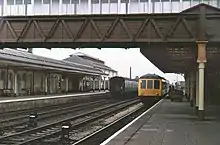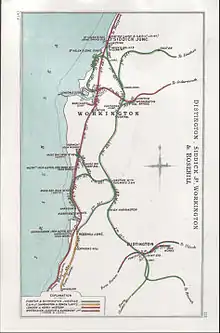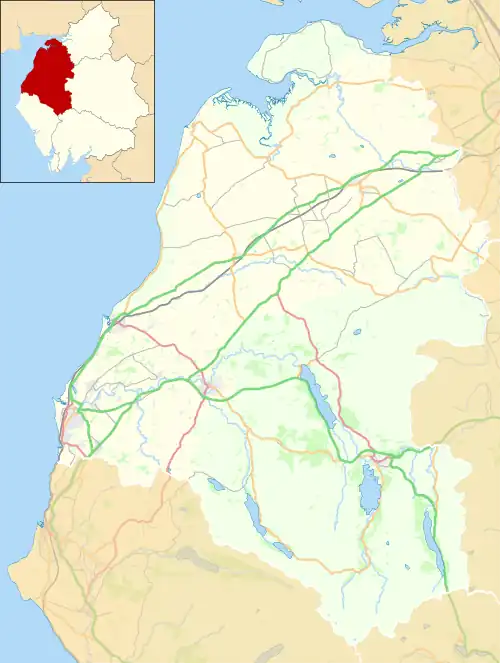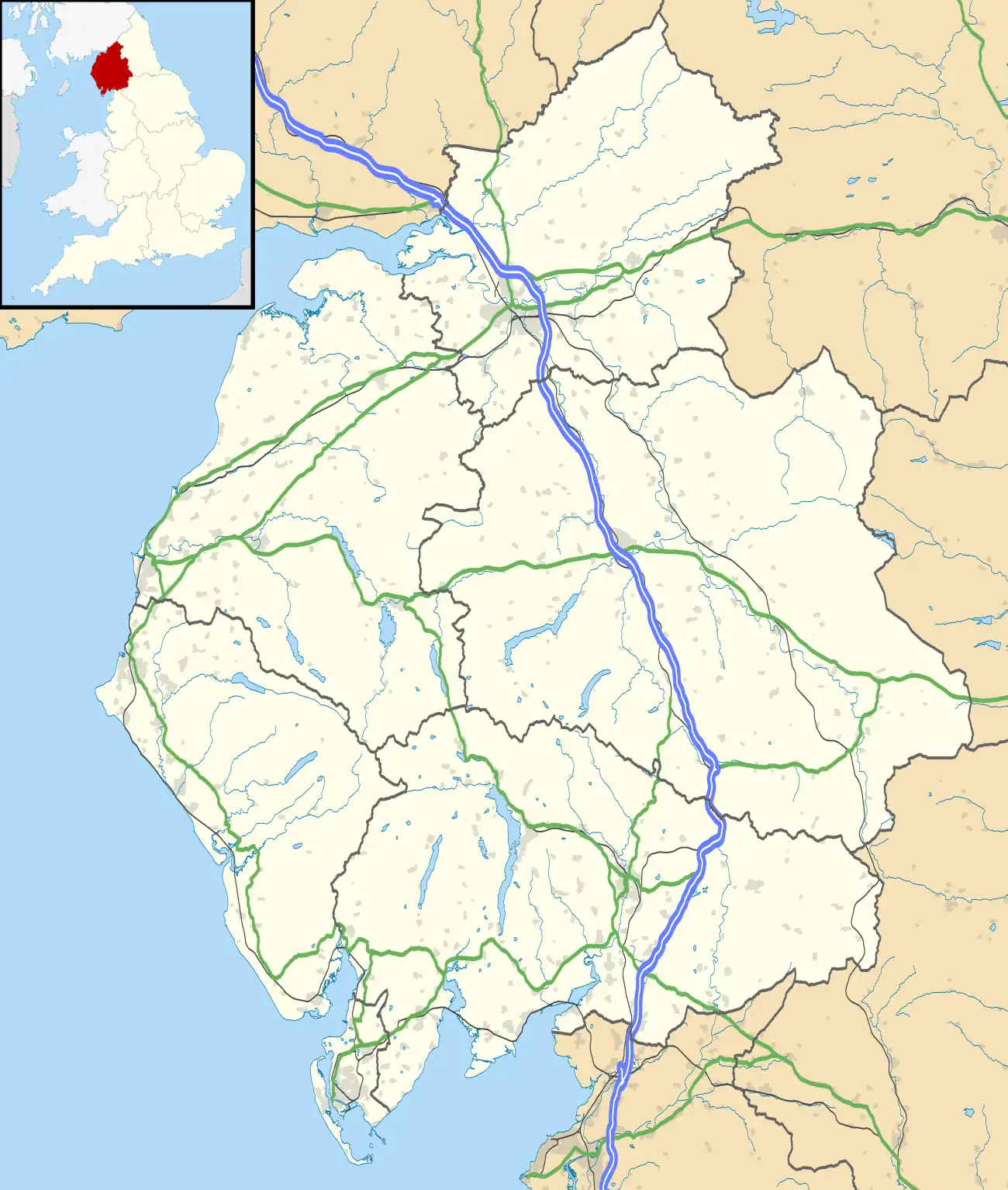Workington railway station
Workington railway station is a railway station serving the coastal town of Workington in Cumbria, England. It is on the Cumbrian Coast Line, which runs between Carlisle and Barrow-in-Furness. It is owned by Network Rail and managed by Northern Trains.
Workington | |
|---|---|
.jpg.webp) | |
| General information | |
| Location | Workington, Cumberland England |
| Coordinates | 54°38′42″N 3°33′32″W |
| Grid reference | NX995288 |
| Owned by | Network Rail |
| Managed by | Northern Trains |
| Platforms | 2 |
| Tracks | 2 |
| Other information | |
| Station code | WKG |
| Classification | DfT category E |
| History | |
| Original company | Whitehaven Junction Railway |
| Pre-grouping | London and North Western Railway |
| Post-grouping | London, Midland and Scottish Railway British Rail (London Midland Region) |
| Key dates | |
| 19 January 1846 | Opened as Workington |
| 2 June 1924 | Renamed Workington Main |
| 6 May 1968 | Renamed Workington |
| Passengers | |
| 2017/18 | |
| 2018/19 | |
| 2019/20 | |
| 2020/21 | |
| 2021/22 | |
| Location | |
| Notes | |
Passenger statistics from the Office of Rail and Road | |
History

The first Workington station on the Cumbrian Coast Line was built in the area known as Priestgate Marsh for the Whitehaven Junction Railway. Although the WJR was opened from Maryport to Workington in 1845[1] the WJR was advertising for tenders for building the station at Workington in October 1846.[2] The WJR station had a single arrival and departure platform (the line was single until 1860) and no platform canopy "the platform is open to the prevailing winds, and " (we) " believe Workington is the only first-class station in Great Britain so unprovided with shelter" complained the Workington town trustees in 1858.[3] In 1854 mis-set points led to a Maryport-Whitehaven goods train being routed into the end bay used by the Workington - Cockermouth trains: the goods train demolished the buffers and "dashed through" the booking office, the porter's office, and the gentleman's waiting room, carrying away the street wall of the station building, and finally coming to rest at the far wall of the ladies' waiting room. The booking office clerk having seen the train approaching, ensured there were no deaths but "the station" reported the Cumberland Pacquet "is of course a perfect wreck" [4] and had to be re-built. (Immediately after the accident, the gas supply to the station was turned off at the meter, but it was noted that three gas lights continued to burn - the town trustees (who owned the town gasworks) declined to restore the supply until the WJR gave a satisfactory explanation or adequate compensation).[5]
The London & North Western Railway took over the Whitehaven Junction and Workington & Cockermouth lines in 1866, and replaced the WJR station. The LNWR station was extended further north than the WJR one, with its principal entrance now facing Station Road; a footpath through the goods yard was suppressed, and South Quay (linking the harbour with the town) was carried over the railway on a bridge, replacing a dangerous level crossing.
At the height of railway development, two other stations served Workington: Workington Bridge on the Cockermouth and Workington Railway, and Workington Central on the Cleator and Workington Junction Railway. - both are now closed. The station on the coast line retained first claim on Workington, but after the opening of Workington Central could be distinguished from it by local papers as 'the Workington low railway station':[6] it could be formally known as Workington LNWR (to distinguish it from Workington Central, Workington Bridge was also an LNWR station) or (post-grouping, when all three stations were LMS) as Workington Main; with the closure of the other stations it has reverted (both formally and informally) to being simply 'Workington' railway station. Trains from the Cockermouth and Keswick direction ended with the closure of that branch to all traffic in April 1966, the line having fallen victim to the Beeching Axe.

Layout
The station was built with yellow Crewe bricks and had four tracks running through the station. Two of the tracks which are not served by platforms were once used to stable Travelling Post Office carriages. There was also a twelve road engine shed, wagon repair shops, a coaling stage, a goods shed and a stable block, all built with local sandstone. In LMS days, a new turntable was installed behind the engine shed. In British Railways days the engine shed was rebuilt with a new roof and ferro-concrete coaling stage and an ash disposal plant was built near to the new turntable. The road approach to the station entrance was remodelled in BR days when the highways near to the station were upgraded. Immediately adjacent to the southbound platform are two carriage sidings, used for stabling & servicing empty DMU sets overnight and at weekends. There is also a train crew depot here.
Facilities
The station is staffed throughout the week (closed in the evenings). There are waiting rooms and covered waiting areas on each platform, which are linked via footbridge. Step-free access is available to both platforms via ramps and a foot level crossing, though this is only open when station staff are present.[7] Outside these times, the only available access routes have steps. A P.A system and digital information screens provide train running information.
Workington North station
Railway stations in Workington | ||||||||||||||||||||||||||||||||||||||||||||||||||||||||||||||||||||||
|---|---|---|---|---|---|---|---|---|---|---|---|---|---|---|---|---|---|---|---|---|---|---|---|---|---|---|---|---|---|---|---|---|---|---|---|---|---|---|---|---|---|---|---|---|---|---|---|---|---|---|---|---|---|---|---|---|---|---|---|---|---|---|---|---|---|---|---|---|---|---|
| ||||||||||||||||||||||||||||||||||||||||||||||||||||||||||||||||||||||
As a consequence of the November 2009 Great Britain and Ireland floods, Network Rail built a temporary additional station 1 mile (1.6 km) from the existing station on waste ground off the A596 adjacent to a business park.[8] An additional hourly shuttle train (composed of a locomotive and at least three former inter-city mainline coaches) operated by Cumbrian-based Direct Rail Services on behalf of Northern Rail, running from Workington northbound to Maryport was created in the aftermath of the floods.[9][10][11] This service started on 30 November 2009 and ran until 28 May 2010.[12] It was initially funded by the Department for Transport at a cost of £216,000. All services between Workington and Maryport were free of charge for this period.[13]
Services
There is generally an hourly service northbound to Carlisle and southbound to Whitehaven with most trains going onward to Barrow-in-Furness (no late evening service operates south of Whitehaven).[14] A few through trains operate to/from Lancaster via the Furness Line.
Train operator Northern introduced a regular through Sunday service to Barrow via the coast at the May 2018 timetable change - the first such service south of Whitehaven for more than 40 years. Services run approximately hourly from mid-morning until early evening, with later trains terminating at Whitehaven. This represents a major upgrade on the former infrequent service of four per day each way to/from Whitehaven only that previously operated.
References
- "Railway Intelligence - Local - Partial Opening of the Whitehaven Junction Railway". Carlisle Patriot. 14 November 1845. p. 3.
- (advertisement): "Whitehaven Junction Railway - Tenders for Building the Station at Workington". Cumberland Pacquet, and Ware's Whitehaven Advertiser. 20 October 1846. p. 1.
- "Workington Town Trustees". Whitehaven News. 25 March 1858. p. 2.
- "Serious Accident on the Whitehaven Junction Railway". Cumberland Pacquet, and Ware's Whitehaven Advertiser. 13 December 1853. p. 3.
- "A Railway Station in Darkness". Carlisle Patriot. 21 January 1854. p. 5.
- e.g. "Assaulting a Railway Official". Cumberland Pacquet, and Ware's Whitehaven Advertiser. 14 November 1889. p. 5.
- Workington station facilities National Rail Enquiries; Retrieved 2 December 2016
- "Station hope for town cut in two". BBC News. 24 November 2009.
- Hume, Colette (30 November 2009). "Workington gets new rail station after Cumbria flood". BBC News Online. Retrieved 30 November 2009.
- "Free shuttle train between Workington and Maryport". Times & Star. Retrieved 29 November 2009.
- "New shuttle service on Cumbrian coast from Monday 30 November". Northern Rail. Archived from the original on 3 December 2009.
- "FREE CUMBRIA FLOODS TRAIN SERVICE TO FINISH NEXT WEEK". Carlisle Times and Star. Archived from the original on 7 March 2012. Retrieved 28 May 2010.
- "New hourly train to help reunite Cumbrian community". Department for Transport. 30 November 2009. Archived from the original on 24 February 2012.
- GB eNRT December 2019 Edition, Table 100
External links
 Media related to Workington railway station at Wikimedia Commons
Media related to Workington railway station at Wikimedia Commons- Train times and station information for Workington railway station from National Rail
| Preceding station | Following station | |||
|---|---|---|---|---|
| Flimby | Northern Trains Cumbrian Coast Line |
Harrington | ||
| Disused railways | ||||
| Workington Bridge | London and North Western Railway Cockermouth and Workington Railway |
Terminus | ||
| Historical railways | ||||
| Workington North | Northern Rail Cumbrian Coast Line |
Harrington | ||
| Siddick Junction | London and North Western Railway Whitehaven Junction Railway |
Harrington | ||

